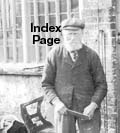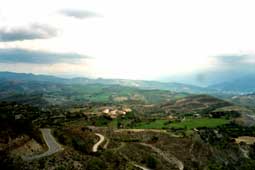 |
Patrick Delaforce & Ken Baldry'The Delaforce Family History' Part Three - The History Book
|
Chapter 41
"Euskadi Ta Askatasuna" (Basque Fatherland and Liberty)
The consequences of Bernard de la Force
|
In an attempt to clear up anomalies in the record as we had it, we decided to trace back from Bernard, all of his ancestors that we could. This seemed a never-ending task while we were at it, because the wives are under-represented. In fact, it was extraordinary how even the daughters of quite important kings (e.g. Dagobert I) are only represented by the names of their husbands. The trees in the last appendix only show parentage and omit brothers & sisters. In the following chapters, the trees show children, whether they are Delaforces or not. Because Bernard was well recorded & of an 'important' family, there is far more light shining upon our ancestors in this earlier period than during the Middle Ages. All history books have an agenda. Below, we are largely interested in Delaforce ancestors and, apart from brief asides, wider issues are neglected. In the previous two chapters, we found some of Bernard's ancestors but the earliest ancestor we know about in our male line is Jimeno Sanchez de Navarre 'El Fuerte' (?764 - ?), a Basque. We know little about him & particularly not why he was 'The Cruel' (el Fuerte). These were cruel times. Spain had been 90% over-run by the Moors, see chapter 45, and Christian Spain had been reduced to Galicia in the North-West, still largely inhabited by the Schwabs (Suevi) & adept, in their harsh landscape, at repelling Moorish incursions and the North coast dukedom of Cantabria. The Basques (Euskaldunak) The word "Gascon" derives from "Vascon" which itself derives from the Roman word for the Basques. The Luxemburger motto "Mir woelle bleive wat mir sin" (we want to stay as we are) applies in spades to the Basques. With their non-Indo-European language, they have remained a distinct ethnic group down to the present. This seems to be because they were the first group to evolve away from the main Homo sapiens line before the last Ice Age.
Thanks, in the first instance, to Jimeno Sanchez, we Delaforces carry Basque blood. Navarre, an alien concept to the Basques as a Kingdom in the Western European tradition, nevertheless was largely a Basque entity. The Romans ignored them politically, the Visigoths (as we shall see) either allied themselves with them or indulged in futile imperial expeditions against them, the Moors either walked through them or laid as light a hand as the Romans on them. Centuries of instability rather worked to the Basques advantage. ETA are just repeating their message of the last 2,100 years: "What part of 'leave us alone' don't you understand?" Maybe that was why Jimeno Sanchez was Cruel, although other scholars have taken issue with this translation of "Fuerte", preferring "Strong" or "Mighty' but, if he was mighty, he should have left a stronger mark on history... The Basques took a pragmatic approach to the Moorish invasion, disappearing into the Pyrenees when the approaching Moorish army looked too big for comfort & reoccupying the North-East when the Moors were distracted by their own civil wars. By the time Jimeno Sanchez was born, the Moors were at least temporarily under the effective government of Abd al-Rahman I. Jimeno Sanchez had two sons, Iñigo Jimenez & Garcia Jimenez. Both are our ancestors & Garcia is the male line one. His son Jimeno Garcia is almost invisible in the records but his grandson, Garcia II (Inigo Iniguez) Jimenez, Prince of Navarre (845 - 890), is not. He married twice, firstly to Oneca Rebelle de Sanguesa (Sanguesa is in the Rioja Area), another shadowy figure with whom he fathered Sancha Garses, who married Galindo II Aznarez de Aragon. Galind is a Gothic personal name. Their daughter was Teresa Endregoto Galindez Countess of Aragon (bfr 920 - 972), sometimes spelt Andgregoto in the record, another Gothic name. She married Garcia I Sanchez King of Navarre (919 - 22/2/970), of our male line & bore Guillaume Terride de Fortun Vicomte de Terride Prince de Verdun & familiar from chapter 40. But this is to rush ahead. That the Basques were making, presumably strategic, marriages, with the Goths (or vice-versa), is interesting. We shall study why there were Visigoths in Spain in chapter 43.
Iñigo Arista was the first King of Navarre & the son of Iñigo Jimenez by his second wife, who name has been lost but was the widow of Musa ibn Fortun, who's suspiciously Moorish name is the subject of the next chapter. Iñigo Arista became king by leading the successful resistance to the Carolingians. What was this about? Alfonso II 'the Chaste', king of Asturias (family tree in chapter 44), had acknowledged Charlemagne's sovereignty in 806, and the links with Gascony were very close despite the apparent barrier of the Pyrenees, which in fact, was never a political frontier until King Ferdinand of Castile annexed the Spanish part of Navarre in 1512. Charlemagne's son, Louis the Pious, sensibly appointed a local Basque, suspiciously called Velasco ('the Basque'?) in the records, as the Count of Navarre but in 824, the Navarrese revolted under Iñigo Jimenez & with the help of a Moorish Beni-Kasim, drove out the Carolingians. By 830, Louis gave up & Iñigo's son, Iñigo Arista is considered the 1st King of Navarre, who was then free to drive out the Moors. He married Velasco's daughter, Onneca. Of their three children. Garcia Iñiguez followed his father as King of Navarre & married twice. His first wife was the mother of Fortun Garces, who's family is the subject of the next chapter. Where Charlemagne comes in will be discussed in his own chapter & we will revisit Navarre in chapter 51. |
To the earlier Kings of Navarre
|
Jimeno Sanchez de Navarre 'El Fuerte (Cruel)' (?764 - ?) a Basque = ?
|
|
Contact: Ken Baldry for more information, 17 Gerrard Road, Islington, London N1 8AY +44(0)20 7359 6294 but best to e-mail him |

